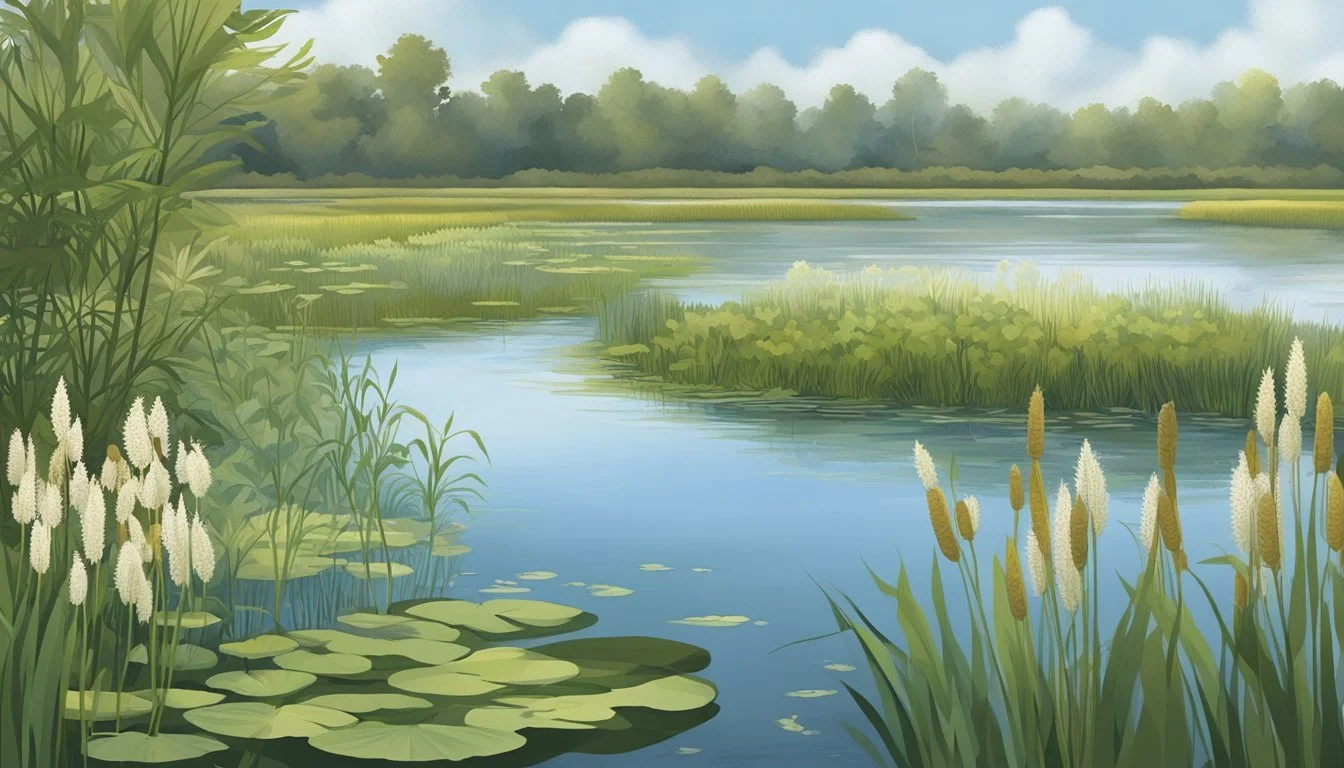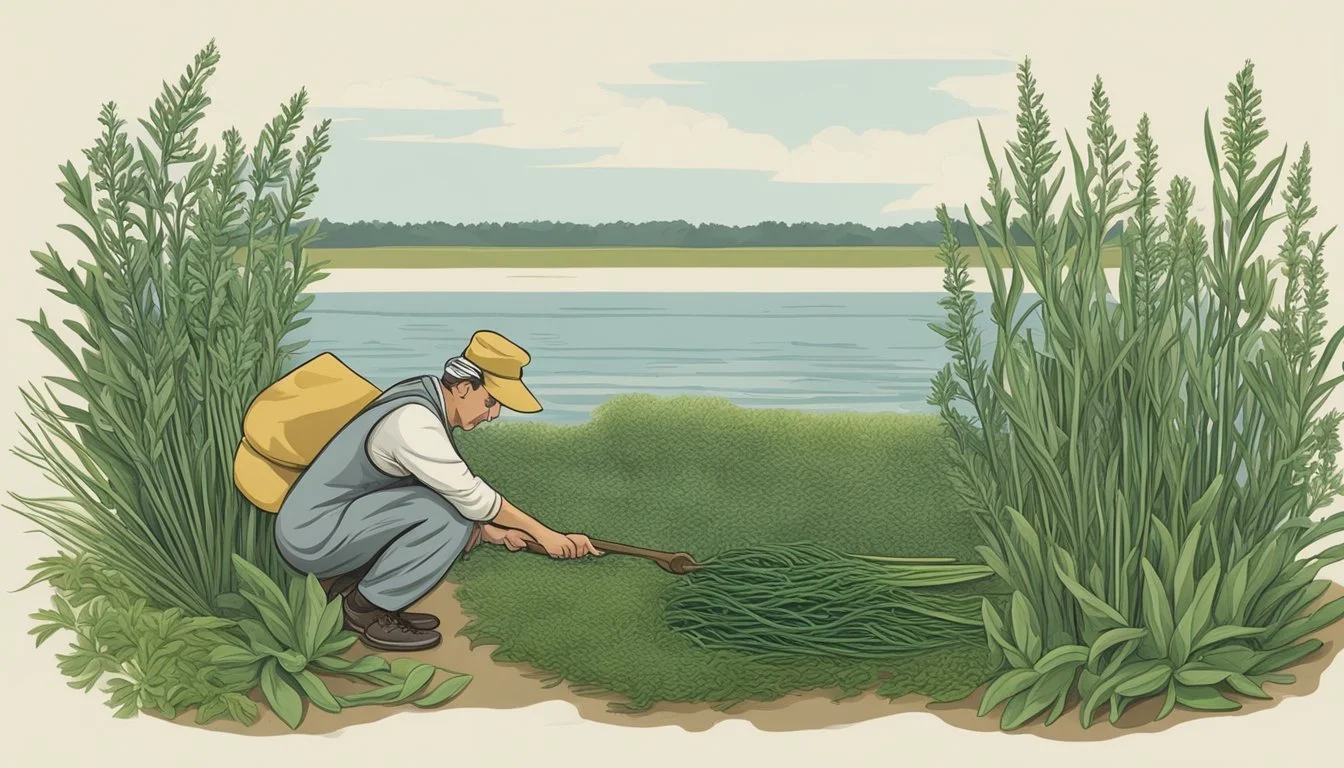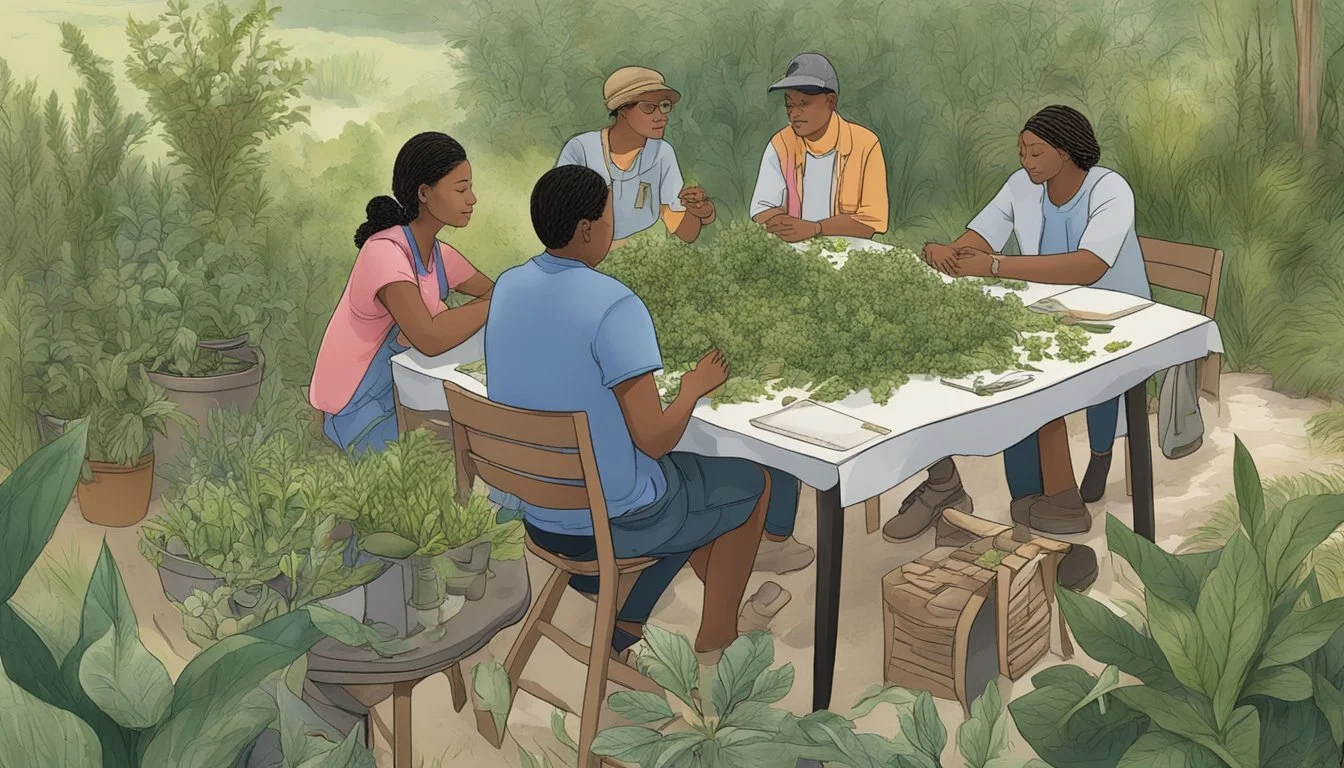Lowcountry Native Edible Plants
A Guide to Sustainable Foraging and Wild Foods
The Lowcountry regions of South Carolina and Georgia are home to a variety of native plants that not only thrive in the local climate but also offer valuable food sources for humans and wildlife. Incorporating these indigenous edible plants into your garden can provide you with a sustainable and nature-friendly way to enjoy the unique flavors of the area. Both novice and seasoned gardeners will find that these plants integrate seamlessly into the local ecosystem, enhancing biodiversity while offering fresh, garden-to-table options.
Native plants like the Georgia Mint attract pollinators such as bees and butterflies, making your garden a buzzing hub of activity. Its aromatic foliage can be brewed into a refreshing tea, adding a Southern touch to your beverages. Meanwhile, the state flower of South Carolina, the Yellow Jessamine, although not edible, can augment the beauty and scent of your garden, creating a pleasing atmosphere alongside your edible crops.
American Holly offers fruits that are a food source for birds, and the Cabbage Palmetto, South Carolina's state tree, has fruits that attract robins and raccoons. These trees support local wildlife while adding structure and visual interest to gardens. By focusing on native edible plants in your Lowcountry garden, you not only contribute to preserving the local flora but also promote a healthy, self-sustaining environment that benefits both you and the diverse wildlife that call this region home.
Historical Significance
The Lowcountry of South Carolina and Georgia boasts a rich history intertwined with native edible plants. Indigenous peoples and early settlers utilized these resources extensively.
Native Americans in the region, including the Cherokee and Creek tribes, relied on plants like the Southern Magnolia and wild strawberries for food, medicine, and cultural practices.
Early colonists in Charleston and surrounding areas adopted many of these native plants. Indigo, a significant crop in South Carolina, was cultivated alongside native species to support the local economy.
In the 18th century, horticultural practices in Lowcountry gardens often included native plants, which were prized for their resilience and contribution to the beautiful Southern landscape. These plants provided sustenance and aesthetic pleasure.
Cultural Heritage: Many of these plants still hold cultural significance today, emblematic of the region's heritage. The indigenous uses and colonial practices have been documented, reflecting their importance in the Lowcountry’s historical narrative.
Plant Examples:
Southern Magnolia (Magnolia grandiflora): Used for its majestic flowers and wood.
Yellow Jessamine (Gelsemium sempervirens): South Carolina’s state flower, valued for its beauty and scent.
Georgia Mint (Pycnanthemum incanum): Used traditionally in teas and remedies.
This blend of native usage and colonial adaptation highlights the enduring significance of Lowcountry native plants. Such plants are integral to understanding the historical and cultural fabric of this unique region.
Understanding Lowcountry Ecosystems
The Lowcountry region, spanning areas in Georgia (GA) and South Carolina (SC), boasts a dynamic ecosystem characterized by its sand dune systems and unique foliage. Interdependence between flora and fauna plays a crucial role in the sustainability of this ecosystem.
Flora and Fauna Interdependence
In the Lowcountry, plants such as Sea Oats and Wax Myrtle are pivotal to the ecosystem. Sea Oats trap wind-blown sand, stabilizing dunes and promoting the growth of dune systems. These plants are essential for many types of wildlife, including birds and insects.
Wax Myrtle, tolerant to drought and deer, provides shelter and food for various species. Its resilience makes it a staple in the local ecosystem, supporting pollinators like bees and butterflies. These plants contribute significantly by offering nectar and seeds.
In this interdependent environment, wildlife such as birds and insects play essential roles in pollination and seed dispersal. Birds help in seed distribution, ensuring the propagation of native flora. Bees and butterflies act as pollinators, indispensable for plant reproduction. This mutual reliance ensures the vibrancy and sustainability of the Lowcountry ecosystem.
Identification of Native Edible Plants
Identifying native edible plants in the Lowcountry involves recognizing specific trees, shrubs, and grasses that produce edible fruits, seeds, or leaves. Knowing these plants helps in foraging and gardening practices.
Trees with Edible Parts
Several native trees in the Lowcountry produce edible parts. The Persimmon (Diospyros virginiana) is notable for its orange-red, sweet fruits that are best harvested after frost. Another significant tree is the Live Oak (Quercus virginiana), whose acorns can be processed into flour after thorough leaching to remove tannins.
The Hickory tree (Carya spp.) yields nuts known for their rich, buttery flavor. These nuts are encased in a hard shell, requiring effort to extract but are highly nutritious. The Eastern Redbud (Cercis canadensis) produces edible flowers and seed pods that can be consumed raw or cooked.
Shrubs and Bushes Bearing Fruits
Native shrubs such as the Wax Myrtle (Morella cerifera) and Sweetspire (Itea virginica) offer edible fruits. The wax myrtle produces small blue berries that are primarily for flavoring, while sweetspire's fragrant white blooms are a sight to behold, although not commonly consumed.
Sassafras (Sassafras albidum) shrubs provide leaves that can be dried and ground to make filé powder, a seasoning used in Creole cuisine. Additionally, Anise (Illicium parviflorum) features aromatic leaves that are typically used to flavor teas and other dishes.
Edible Grasses and Groundcover
Among native grasses, Sea Oats (Uniola paniculata) are significant for their ecological role and aesthetic appeal, but are also used in traditional recipes. The seeds of sea oats can be harvested and ground into flour or used whole in culinary applications.
Wild Onion (Allium spp.) is another groundcover that thrives in the Lowcountry. Its bulbs and green tops are entirely edible and impart a strong onion flavor to various dishes. These are often found in sunny, open areas and are relatively easy to identify by their characteristic smell.
These native plants are integral to the ecosystem and provide a sustainable source of food for those interested in foraging or gardening with indigenous flora.
Seasonal Wild Edibles and Harvesting
Exploring the Lowcountry's native edible plants requires a keen sense of timing. Each season brings its own unique set of harvestable plants, offering a year-round opportunity for foraging.
Spring and Summer Delights
Spring introduces a variety of fresh greens and blooms. Among these, wood sorrel and stinging nettles emerge. Wood sorrel (Oxalis spp.) offers a tangy flavor and is often found in shaded, moist areas.
Nettles (Urtica dioica) provide nutritious, versatile greens but require careful handling due to their stinging hairs. Red chard can also be found, adding another layer of fresh, nutritious options for foragers. Wild onions, with their fresh and slightly tangy flavor, also start surfacing around this time, contributing their distinctive taste to a variety of dishes.
Autumn Harvest
Autumn is the season for harvesting nuts and fruits. The Lowcountry’s oak trees drop an abundance of acorns, which, after careful processing to remove tannins, can be transformed into flour or roasted as snacks.
Persimmons become a sweet treat in autumn; their bright orange fruits are ripe and ready for harvest. Alongside these, foragers can find the protein-rich seeds of the pine nut, offering a nutritious option to gather. The season also brings chokecherries, whose tangy fruits can be made into jellies or syrups.
Winter Foraging
Winter might seem sparse, but the hardy evergreen plants provide sustenance. Pine needles can be brewed into a vitamin C-rich tea, while young needles add a fresh zest to dishes.
Winter foraging often includes starchy tubers such as Indian potatoes, found in sheltered, wet areas. These tubers store well through the colder months and can be cooked in stews or roasted. Evergreen herbs like rosemary and thyme also thrive, offering flavorful options even in the chill.
Environmental Benefits of Native Edible Plants
Native edible plants offer numerous environmental benefits. In regions like Georgia (GA) and South Carolina (SC), these plants are perfectly adapted to the local soil and climate conditions.
Native plants often require less water and fertilizer. This reduces the strain on local water resources and minimizes the introduction of chemicals into the environment.
The root systems of native plants help to prevent soil erosion. Their roots hold the soil in place, particularly in sandy areas, maintaining the ecosystem's health.
Native edible plants play a significant role in supporting wildlife. They provide food and habitat for various species, from insects to larger animals. For example, they can be crucial for pollinators like bees and butterflies.
The foliage of native plants is adapted to withstand local pests and diseases. This decreases the need for chemical pesticides and creates a more sustainable environment.
These plants contribute to the local ecology by competing effectively with invasive species. They help maintain biodiversity and the natural balance within ecosystems.
Incorporating native edible plants into landscaping promotes a deeper connection with nature. It fosters an appreciation for regional flora and the intricate relationships within local ecosystems.
Culinary Uses in American Cuisine
Catbrier Shoots
Catbrier shoots, sometimes known as greenbrier, offer a crisp, slightly tangy flavor. Chefs use them in salads or as a crunchy component in stir-fry dishes. Their mild bitterness pairs well with honey-based dressings.
Cherokee Rose Hips
Rich in vitamin C, Cherokee rose hips are often brewed into teas or incorporated into jellies and sauces. These small fruits add a sweet-tart punch to both desserts and savory dishes, enhancing the flavor profile.
Muscadine Grapes
Muscadine grapes are popular for making wines, jellies, and pies. Their thick skins and robust flavor make them a standout ingredient. Restaurants often feature muscadine-glazed meats and fish, adding a local twist to traditional recipes.
Pawpaw Fruits
Pawpaw fruits, noted for their creamy texture and tropical taste, are excellent in desserts like ice cream and custards. Some chefs also blend pawpaw pulp into smoothies for a unique, fruity addition.
Green Beans and Squash
Originating from Native American gardens, green beans and squash remain staples in many Lowcountry recipes. These vegetables are frequently roasted, steamed, or sautéed, complementing a wide range of meat and fish dishes.
Wild Rice
Wild rice is a versatile ingredient found in hearty soups, casseroles, and as a side dish. Its nutty flavor and chewy texture pair well with mushrooms, meats, and various greens, adding a satisfying element to meals.
Hickory Nuts
Hickory nuts are utilized in baking for their rich, buttery taste. They appear in cookies, breads, and as a topping for salads. Ground into a meal, these nuts can be used to crust fish, providing a crunchy texture and earthy flavor.
Oyster Mushrooms
Oyster mushrooms, with their delicate texture and mild taste, are popular in Lowcountry cuisine. Sautéed in butter or olive oil, they are often served over meats or incorporated into sauces and soups.
Prickly Pear Cactus
The pads and fruits of the prickly pear cactus add unique flavors to dishes. The pads, known as nopales, are grilled or sautéed, while the fruits are used in syrups, jellies, and beverages.
Incorporating these native plants into cuisine not only preserves traditional flavors but also promotes sustainable eating practices.
Conservation and Sustainable Practices
Conservation and sustainable practices are essential to preserving the natural diversity of Lowcountry native edible plants. Protecting these plants ensures that they remain a resource for future generations.
Maintaining Habitats
Native habitats must be protected to support local wildlife and plant species. Conservation efforts involve protecting natural areas from urbanization and industrial development.
Support Local Farmers
Encouraging local farmers to grow native edible plants on their land can help maintain biodiversity. Providing incentives to farmers can promote the cultivation of these species and reduce the pressure on wild populations.
Organic Practices
Using organic farming methods can minimize the negative impact on the environment. Avoiding chemicals and synthetic fertilizers helps protect soil and water quality, which are vital for the health of native plant ecosystems.
Community involvement
Involving local communities in conservation efforts can have a significant positive impact. Education and outreach programs can raise awareness about the importance of native plants and sustainable practices.
Guidelines and Policies
Creating and implementing guidelines for the conservation and sustainable use of native plants is crucial. Policies should aim to balance conservation with sustainable harvesting to ensure that native edible plants remain abundant.
These practices contribute to a balanced ecosystem where native plants thrive, benefiting both nature and local communities.
Gardening with Native Edibles
Creating a garden with native edibles involves selecting well-adapted plants for your local environment, ensuring proper soil and water conditions, supporting pollinators, and managing pests effectively.
Plant Selection and Placement
Choosing the right native plants is crucial. In the Lowcountry, popular choices include sweetgrass, Carolina Jessamine, and yaupon holly. These plants are well-adapted to the local climate and soil conditions.
Sweetgrass thrives in sandy soils and can handle drought once established. Carolina Jessamine prefers part shade and adds vibrant color. Yaupon holly, a known native edible, is ideal for sunny spots and offers both ornamental and practical benefits. Strategically place plants to match their sun and shade needs for optimal growth.
Soil and Water Considerations
Lowcountry soils can vary from sandy to clay-heavy. Testing soil pH is essential; native edibles like American cranberry require acidic soil with a pH between 4.0 and 5.2. Adding organic matter such as compost can improve soil texture and fertility.
Proper watering is key. Many native edibles need consistently moist soil, especially during establishment. Drip irrigation can help maintain consistent moisture levels without overwatering. Understanding water needs helps conserve resources and supports healthy plant growth.
Pollinator-Friendly Gardening
Supporting bees, butterflies, and other pollinators enhances garden productivity and biodiversity. Planting native flowers like sweetgrass and shrubs that provide nectar and pollen helps attract beneficial insects. Carolina Jessamine, for example, is a favorite of bees and butterflies.
Creating habitat diversity by including trees, shrubs, and ground covers fosters a thriving pollinator-friendly ecosystem. Avoid pesticides that harm pollinators, and provide water sources like shallow dishes with stones where insects can safely drink.
Pest Management and Companion Planting
Effective pest management combines cultural practices and companion planting. Use plants that naturally repel pests or attract beneficial insects. For example, planting native herbs like mint and rosemary can deter pests.
Introducing beneficial insects like ladybugs and predatory beetles helps control pest populations. Companion planting with species that support each other's growth can reduce the need for chemical interventions. Regular monitoring and prompt action keep pest issues manageable.
Incorporating native edible plants into your garden enhances ecological health and provides fresh produce. By selecting the right plants, ensuring ideal growing conditions, supporting pollinators, and employing smart pest management strategies, gardeners can cultivate a vibrant, sustainable native garden.
Educational Resources and Community Engagement
In the Lowcountry region of Georgia and South Carolina, a wealth of educational resources exist to enhance knowledge about native edible plants.
Local universities often partner with botanists and garden centers to offer workshops and courses.
The University of Georgia and Clemson University provide specialized programs focusing on native plants and their uses. Additionally, local county extension offices serve as valuable hubs for educational materials.
Community involvement plays a crucial role in promoting awareness.
Nature clubs and wildlife organizations frequently host foraging tours and educational walks to highlight native species. Group activities foster a sense of community and enable real-life foraging experiences.
Local garden centers are excellent places to learn about native plant gardening.
Many centers offer classes on how to cultivate and cook with native plants. They may also provide plant exchanges and advice on sustainable gardening practices.
To keep communities engaged, educational institutions often collaborate with local schools.
Implementing edible education programs in schools helps students connect with nature early on. This method emphasizes hands-on learning and encourages a lifelong interest in the environment.
For those interested in further learning, online portals and libraries offer extensive resources.
Websites featuring interactive content, forums, and instructional videos can serve as continuous learning platforms. These resources ensure that knowledge about Lowcountry's native edible plants remains accessible to everyone.










